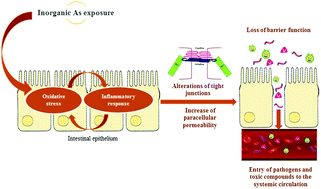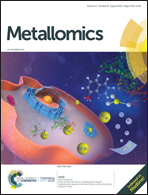Inorganic arsenic causes intestinal barrier disruption
Abstract
Inorganic arsenic (As) is the most toxic form of As found in food and water. Gastrointestinal disorders have been reported in populations chronically exposed to this arsenical form or to one of its metabolites; however, studies to determine the mechanisms of inorganic As toxicity at the intestinal level are scarce. The aim of this study is to determine the mechanisms of toxicity of inorganic As [As(III) and As(V)] on intestinal epithelial cells. For this purpose, two human intestinal cell models were used: non-transformed colon epithelial cells (NCM460) and epithelial cells from a colorectal adenocarcinoma (Caco-2). Exposure to As(III) and As(V) generates an increase in the release of the pro-inflammatory cytokine IL-8 (57–1135%) and an increase in the generation of reactive oxygen and/or nitrogen species (130–340%) in both cell lines. This pro-inflammatory and pro-oxidant response may be responsible for the structural and functional modifications demonstrated in the monolayers formed by both cell types. Treatments with As(III) and As(V) produce a redistribution of zonula occludens 1 and a reduction in the expression of claudin 1, tight junction proteins that participate in maintaining the structure of the epithelium. All these toxic effects are finally translated into a loss of the barrier function of intestinal monolayers.



 Please wait while we load your content...
Please wait while we load your content...